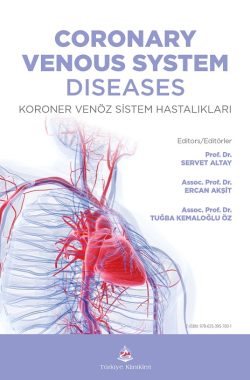EMBRYOLOGY OF THE CORONARY VENOUS SYSTEM
Özge Turgay Yıldırım1 Mehmet Özgeyik2
1Eskişehir City Health Application and Research Center, Department of Cardiology, Eskişehir, Türkiye
2Eskişehir City Health Application and Research Center, Department of Cardiology, Eskişehir, Türkiye
Turgay Yıldırım Ö, Özgeyik M. Embryology of the Coronary Venous System. In: Altay S, Akşit E, Kemaloğlu Öz T editor. Coronary Venous System Diseases. 1st ed. Ankara: Türkiye Klinikleri; 2025. p.1-8.
ABSTRACT
The coronary venous system, essential for removing myocardial metabolic waste and returning blood to the right atrium, holds significant importance in diagnostic and interventional cardiology. It serves as a critical access route for procedures such as cardiac resynchronization therapy, retrograde cardioplegia delivery, and other diagnostic interventions. A thorough understanding of the embryological events behind the development of this system is vital for diagnosing and managing related diseases and anomalies. The coronary venous network is formed through the intricate remodeling of the sinus venosus and the primitive subepicardial vascular plexus, guided by molecular pathways such as VEGF, Eph/ Ephrin, COUP-TFII, and Notch signaling. These pathways regulate endothelial proliferation, vascular plexus remodeling, and venous identity in response to hemodynamic forces.
The coronary sinus, a central structure in this network, emerges from the left sinus horn and parts of the left anterior cardinal vein. In contrast, its tributaries—the great, middle, and small cardiac veins— originate independently from the subepicardial vascular plexus, which forms from epicardium-derived cells. Channel selection within this plexus ensures the formation of major veins, with molecular guidance and hemodynamic forces directing venous patterning and connection to the coronary sinus or right atrium. Errors in this complex progression can result in anomalies such as persistent left superior vena cava, coronary sinus atresia, and unroofed coronary sinus, disrupting cardiac venous return and potentially leading to clinical challenges.
The detailed knowledge of these embryological mechanisms not only furthers understanding of congenital disorders and acquired diseases but also establishes a foundation for safe and effective interventional strategies. This chapter emphasizes the anatomical and molecular intricacies of coronary venous development, linking them to clinically relevant scenarios to aid better diagnostic and therapeutic outcomes in modern cardiology.
Keywords: Coronary vessels; Embryology; Coronary sinus; Cardinal veins; Vascular endothelial growth factor A; COUP transcription factor II
Kaynak Göster
Referanslar
- Sirajuddin A, Chen MY, White CS, Arai AE. Coronary venous anatomy and anomalies. J Cardiovasc Comput Tomogr. 2020;14(1):80-86. [Crossref] [PubMed]
- The fetal venous system, Part I: normal embryology, anatomy, hemodynamics, ultrasound evaluation and Doppler investigation Yagel 2010 Ultrasound in Obstetrics & Gynecology Wiley Online Library. Accessed April 11, 2025.
- Dees E, Baldwin HS. 50 Developmental Biology of the Heart. In: Gleason CA, Juul SE, eds. Avery's Diseases of the Newborn (Tenth Edition). Elsevier. 2018:724-740.e3. [Crossref]
- Common Cardinal Veins an overview | ScienceDirect Topics. Accessed April 11, 2025.
- Carlson BM. Development of the Vascular System. In: Reference Module in Biomedical Sciences. Elsevier; 2014. [Crossref]
- Verma M, Pandey NN, Ojha V, Kumar S, Ramakrishnan S. Developmental anomalies of the superior vena cava and its tributaries: What the radiologist needs to know? Br J Radiol. 2021;94(1118):20200856. [Crossref] [PubMed] [PMC]
- Nowak D, Kozłowska H, Żurada A, Gielecki J. Development of the cardiac venous system in prenatal human life. Cent Eur J Med. 2011;6(2):227-232. [Crossref]
- Mozes G, Gloviczki P. Chapter 2 Venous Embryology and Anatomy. In: Bergan JJ, ed. The Vein Book. Academic Press. 2007:15-25. [Crossref]
- Maher T, Stabenau HF, d'Angelo R, Yang S, Scanavacca M, d'Avila A. Interventions for coronary sinus access with an obstructing Thebesian valve. Hear Case Rep. 2024;10(10):738741. [Crossref] [PubMed] [PMC]
- Shah SS, Teague SD, Lu JC, Dorfman AL, Kazerooni EA, Agarwal PP. Imaging of the Coronary Sinus: Normal Anatomy and Congenital Abnormalities. RadioGraphics. 2012;32(4):991-1008. [Crossref] [PubMed]
- Xie M xing, Yang Y li, Cheng TO, et al. Coronary sinus septal defect (unroofed coronary sinus): Echocardiographic diagnosis and surgical treatment. Int J Cardiol. 2013;168(2):12581263. [Crossref] [PubMed]
- Mantini E, Grondin CM, Lillehei CW, Edwards JE. Congenital anomalies involving the coronary sinus. Circulation. 1966;33(2):317-327. [Crossref]
- Thiene G, Frescura C, Padalino M, Basso C, Rizzo S. Coronary Arteries: Normal Anatomy With Historical Notes and Embryology of Main Stems. Front Cardiovasc Med. 2021;8. [Crossref] [PubMed] [PMC]
- Buijtendijk MFJ, Barnett P, van den Hoff MJB. Development of the human heart. Am J Med Genet C Semin Med Genet. 2020;184(1):7-22. [Crossref] [PubMed] [PMC]
- Hamada K, Oike Y, Ito Y, et al. Distinct roles of ephrin-B2 forward and EphB4 reverse signaling in endothelial cells. Arterioscler Thromb Vasc Biol. 2003;23(2):190-197. [Crossref] [PubMed]
- Aoyagi Y, Schwartz AW, Li Z, et al. Changes in vascular identity during vascular remodeling. JVS-Vasc Sci. 2025;6:100282. [Crossref] [PubMed] [PMC]
- Kassem MW, Lake S, Roberts W, Salandy S, Loukas M. Cardiac veins, an anatomical review. Transl Res Anat. 2021;23:100096. [Crossref]
- Cao Y, Duca S, Cao J. Epicardium in Heart Development. Cold Spring Harb Perspect Biol. 2020;12(2):a037192. [Crossref] [PubMed] [PMC]
- Lee JE, Kwon SH, Oh JH. Congenital Anomalies of the Coronary Sinus: A Pictorial Essay. J Korean Soc Radiol. 2013;69(1):29-37. [Crossref]
- Nordick K, Weber C, Singh P. Anatomy, Thorax, Heart The besian Veins. In: StatPearls. StatPearls Publishing; 2025. Accessed April 14, 2025.
- Herbert SP, Stainier DYR. Molecular control of endothelial cell behaviour during blood vessel morphogenesis. Nat Rev Mol Cell Biol. 2011;12(9):551-564. [Crossref] [PubMed] [PMC]
- You LR, Lin FJ, Lee CT, DeMayo FJ, Tsai MJ, Tsai SY. Suppression of Notch signalling by the COUP-TFII transcription factor regulates vein identity. Nature. 2005;435(7038):98-104. [Crossref] [PubMed]
- Reese DE, Mikawa T, Bader DM. Development of the Coronary Vessel System. Circ Res. 2002;91(9):761-768. [Crossref] [PubMed]

